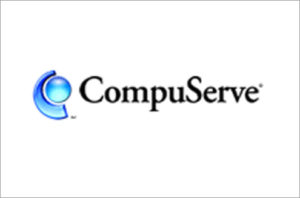
Date: 01/01/1980In 1979, CompuServe became the first service to offer electronic mail capabilities and technical support to personal computerusers. The company broke new ground again in 1980 as the first to offer real-time chat with its CB Simulator. Other major dial-in networks were AmericaOnline (AOL) and Prodigy that also provided communications, content, and entertainment features. Many bulletin board system (BBS) networks also providedon-line access, such as FidoNet which was popular amongst hobbyist computer users, many of them hackers and amateur radio operators.
CompuServe was founded in 1969 as Compu-Serv Network, Inc. (the earliest advertising shows the name with initial caps) in Columbus, Ohio, as a subsidiary of Golden United Life Insurance. While Jeffrey Wilkins, the son-in-law of Golden United founder Harry Gard, Sr., is widely credited as the first president of CompuServe, the initial president was actually Dr. John R. Goltz.[1] Goltz and Wilkins were both graduate students in electrical engineering at the University of Arizona. Early employees also recruited from the University of Arizona included Sandy Trevor (inventor of the CompuServe CB Simulator chat system), Doug Chinnock, and Larry Shelley. Wilkins replaced Goltz as CEO within the first year of operation.
The company objectives were twofold: to provide in-house computer processing support to Golden United Life Insurance; and to develop as an independent business in the computer time-sharing industry, by renting time on its PDP-10 midrange computers during business hours. It was spun off as a separate company in 1975, trading on the NASDAQ under the symbol CMPU.
Concurrently, the company recruited executives who shifted the focus from offering time-sharing services, in which customers wrote their own applications, to one that was focused on packaged applications. The first of these new executives was Robert Tillson, who left Service Bureau Corporation (then a subsidiary of Control Data, but originally formed as a division of IBM) to become CompuServe’s Executive Vice President of Marketing. He then recruited Charles McCall (who followed Jeff Wilkins as CEO, and later became CEO of medical information firm HBO & Co.), Maury Cox (who became CEO after the departure of McCall), and Robert Massey (who followed Cox as CEO). Barry Berkov was recruited from Xerox to head product development and marketing.
In 1977, CompuServe’s board changed the company’s name to CompuServe Incorporated. In 1980, H&R Block acquired CompuServe. The purchase provided cash to expand operations, and helped H&R Block diversify its tax-season based earnings.
Technology
The original 1969 dial-up technology was fairly simple—the local phone number in Cleveland, for example, was a line connected to a time-division multiplexer that connected via a leased line to a matched multiplexer in Columbus that was connected to a time-sharing host system. In the earliest buildups, each line terminated on a single machine at CompuServe’s host, so different numbers had to be used to reach different computers.
Later, the central multiplexers in Columbus were replaced with PDP-8 minicomputers, and the PDP-8s were connected to a DEC PDP-15 minicomputer that acted as switches so a phone number was not tied to a particular destination host. Finally, CompuServe developed its own packet switching network, implemented on DEC PDP-11 minicomputers acting as network nodes that were installed throughout the US (and later, in other countries) and interconnected. Over time, the CompuServe network evolved into a sophisticated multi-tiered network incorporating Asynchronous Transfer Mode (ATM), Frame relay (FR), Internet Protocol (IP) and X.25 technologies.
In 1981, The Times explained CompuServe’s technology in one sentence:
Compuserve is offering a video-text-like service permitting personal computer users to retrieve software from the mainframe computer over telephone lines. CompuServe was also a world leader in other commercial services. One of these was the Financial Services group, which collected and consolidated financial data from myriad data feeds, including CompuStat, Disclosure, I/B/E/S as well as the price/quote feeds from the major exchanges. CompuServe developed extensive screening and reporting tools that were used by many investment banks on Wall Street.
CIS
The consumer information service had been developed almost clandestinely, in 1978, and marketed as MicroNET through Radio Shack. Many within the company did not favor the project; it was called schlock time-sharing by the commercial time-sharing sales force. It was allowed to exist initially because consumers used the computers during evening hours, when the CompuServe computers were otherwise idle. As it became evident that it would be a hit, CompuServe dropped the MicroNET name in favor of their own. CompuServe’s origin was approximately concurrent with that of The Source. Both services were operating in early 1979, being the first online services. MicroNet was made popular through the Issue 2 of Commodore Disk User, which included programs on how to connect and run MicroNet programs.
By the mid-1980s CompuServe was one of the largest information and networking services companies in existence, and it was the largest consumer information service in the world. It operated commercial branches in more than 30 US cities, selling primarily network services to major corporations throughout the United States. Consumer accounts could be bought in most computer stores (a box with an instruction manual and a trial account login) and awareness of this service was extremely high. By 1987, the consumer side would be 50% of CompuServe revenues. The service continued to improve in terms of user interface and offerings, and in 1989 CompuServe purchased and dismantled one of its main competitors, The Source.
The corporate culture was entrepreneurial, encouraging “skunkworks projects”. Alexander “Sandy” Trevor secluded himself for a weekend, writing the “CB Simulator”, a chat system that soon became one of CIS’s most popular features. Instead of hiring employees to manage the forums, they contracted with sysops, who received compensation based on the success of their own forum’s boards, libraries, and chat areas.
In September 2003 CompuServe Information Service, which had become a division of AOL, added CompuServe Basic to its product lines, selling via Netscape.com. AOL offered the CompuServe Basic service to departing AOL members, possibly in response to reports earlier that year that AOL was losing significant business to low-cost competitors.